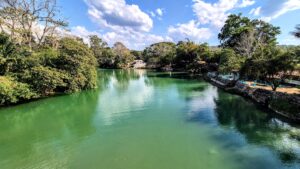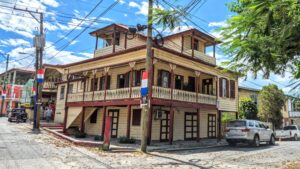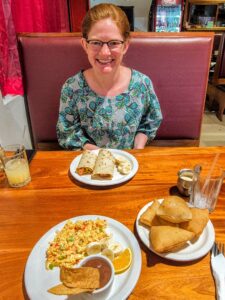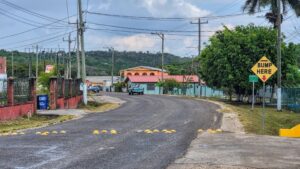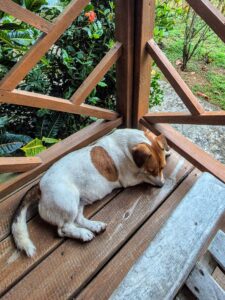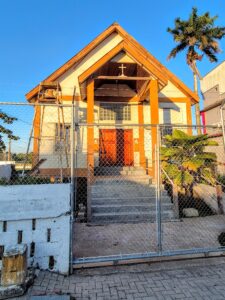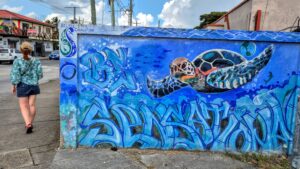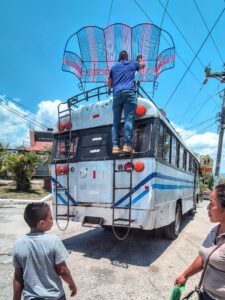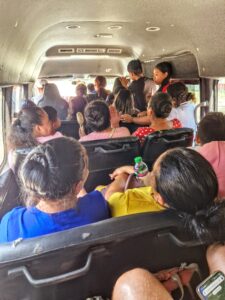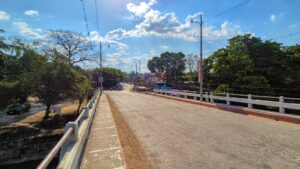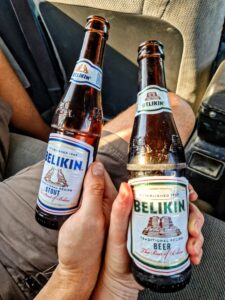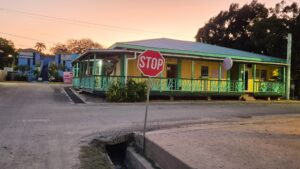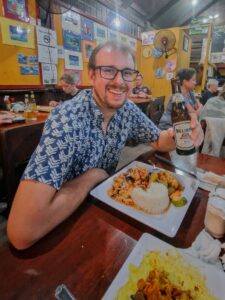We extended our trip by a few days, changing our flight to go home from Belize. This had the dual benefit of avoiding two flights to get us to Mexico City, and having a couple of days exploring Belize. Whilst most people head for the Caribbean coast and popular dive spots, we went to San Ignacio, near the border to Guatemala. We barely scratched the surface of this country, but saw some incredible Mayan sites.
We set off from Saraguate Hostel in Guatemala, arriving into Flores by an easy bus journey chatting to a couple we’d met at the hostel. We got a tuk-tuk across to the bus station and were immediately whisked away to a minibus ‘colectivo’ heading to the Guatemalan border town of Melchor de Mencos. Our bags were flung on the roof and we grabbed the back seat. We set off, pleased to have the whole back row to ourselves. This was very short lived as we then stopped back in the main market and the bus began to fill up. Our bags were then properly strapped onto the roof along with various other bags and a child’s bicycle.
We set off at a good pace, picking up the occasional person, even when I thought we couldn’t get many more people on board the driver kept stopping! We then came to a grinding halt for some roadworks. We sat in the still hot air for about 45 minutes, dripping with sweat and unable to move much in the crowded bus. Our driver seemed to anticipate the length of wait as he stopped in a shady spot, with a large gap before the end of the queue in front of us. Eventually we managed to get moving again. It turned out the road was in the middle of being dug up for resurfacing, there were no traffic lights, no signs, and no one really controlling the traffic, you just had to get into the moving convoy and go! We drove right through the road works whilst they were laying sand and busy working around the traffic.
We made it safely to the border town and were directed to walk across the bridge to cross the border, at this point we hadn’t actually done a border where we had to show our own passports since leaving Costa Rica! We changed our final Guatemalan notes with a guy on the street just before the border. It’s so much easier to do this now when you can just check the rate on your phone and work out if you’re getting an OK deal or not. The border crossing was very smooth and we were soon in Belize.
Our first experience of Belizian hospitality was our taxi driver from the border to San Ignacio. We got chatting to him and asked him about the best food and drink to try in the country, the next thing we know, he’s pulling over to buy us both a beer each to enjoy on the ride!
Immediately on crossing the border it felt like a much more Caribbean country, rather than Central American. This was in part due to the English language signs, but also just a different look to the houses, and the mix of people you saw. We found people in San Ignacio spoke a mixture of English and Spanish, and a lot of people we spoke to were a mix of heritage with family in Guatemala or Mexico.
We had booked ourselves into Mana Kai campground for the last three nights of our travels. We’d chosen this as we wanted a nice relaxed stay, rather than a hectic hostel, with a few nights good sleep before the long journey home. The campground had excellent reviews and it lived up to them. We could walk into town easily and cooked for ourselves one night as well (finishing up the last of our ’emergency’ noodles we’d been carrying around). The owner, Francisco, was really helpful and got us booked in for a big caving tour on our final day.
That first evening we had a nice meal out at Guava Limb restaurant, with some great cocktails and enormous cakes for pudding. We hadn’t had a meal out just the two of us for a while, it was nice to get dressed up and treat ourselves.
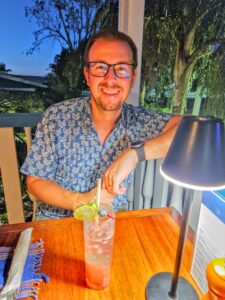
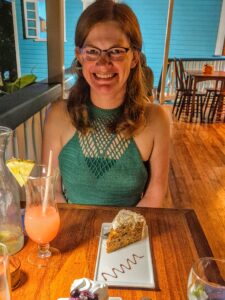
We had a lie-in the next day and sorted a few bits and bobs out. I was feeling frustrated as I’d managed to leave my new kindle and an eye mask at the last hostel, our first loss in three months so not too bad, but still annoying!
In the afternoon we headed out to explore. We visited the nearby Mayan site of Cahal Pech. It wasn’t on the same scale as Tikal, but was still really interesting to wander around, and you could explore inside some of the buildings too. We met a local family and got chatting to them, his grandfather had been stationed in Scotland during World War II. It was fascinating to chat to him, we discussed careers, politics, and even the monarchy. It made me realise that although our Spanish has improved so much, we still aren’t able to easily dive into these kinds of conversations and really get the same local insights in other countries with the language barrier.
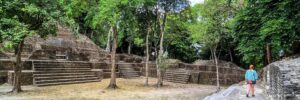
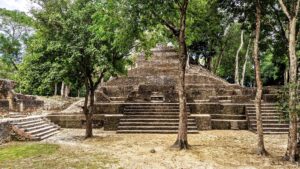
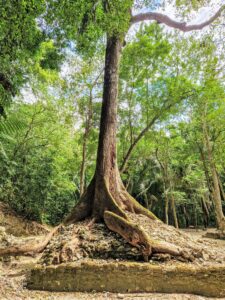
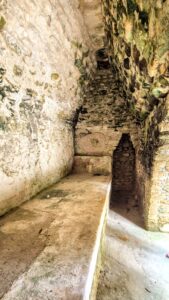
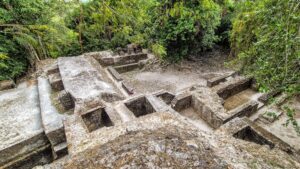
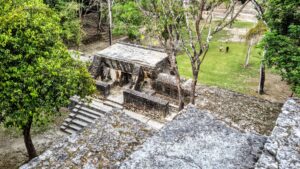
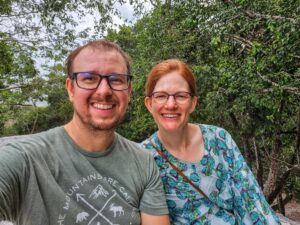
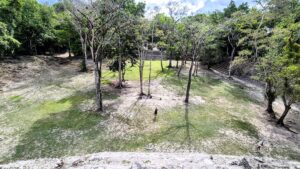
We left the site just as a shower started, we ran through the trees enjoying the cool refreshing rain. We sheltered briefly in the museum building and the rain soon eased and we headed out to our next stop, the Green Iguana Conservation Project based in the grounds of a fancy hotel. The green iguana is a popular pet (often abandoned when they get past the cute and small baby stage) and even a local delicacy (apparently pregnant females are particularly sought out at Easter time), therefore the breeding and education programme here is valuable. We got to stroke, and even hold the large breeding iguanas, see the egg laying area, and then see the bright green baby iguanas. Our guide placed these on our heads, where they scrabbled around to get themselves comfortable, one crawled off down my back! After a few minutes we picked them back up and put them back safely in their pen.
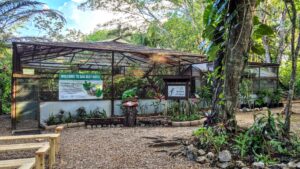
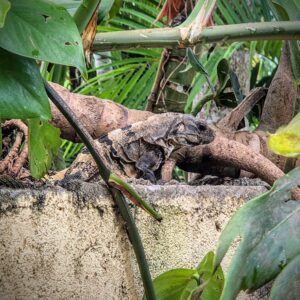
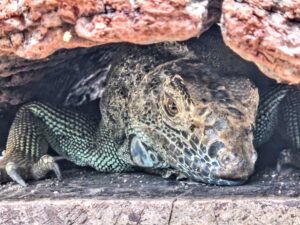
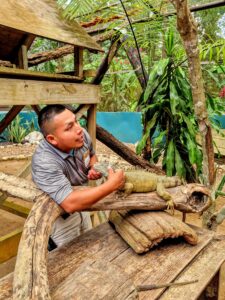
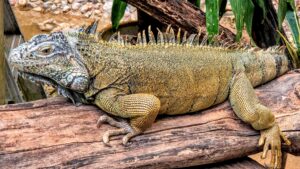
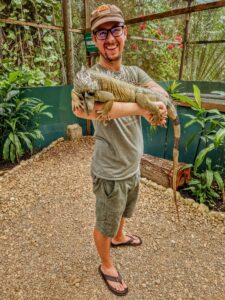
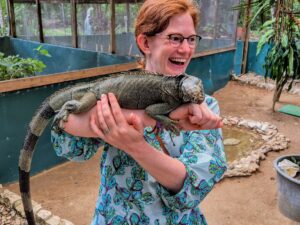
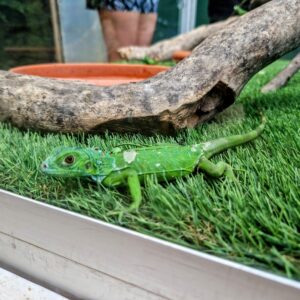
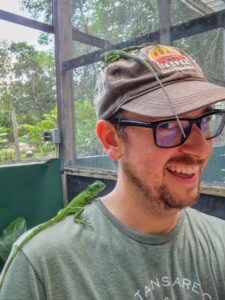
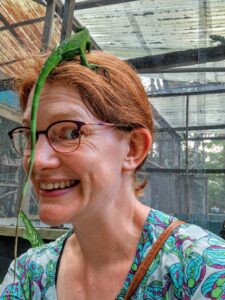
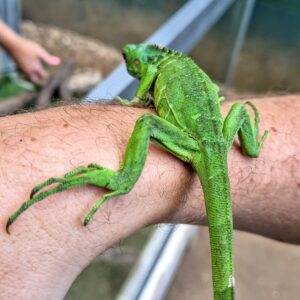
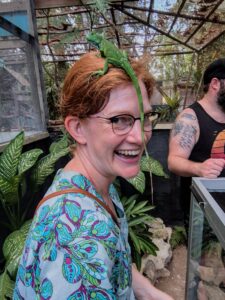
The ATM caves were our last adventure of the trip. This large expanse of underground caverns near San Ignacio are famous for Mayan finds deep inside them, including pottery and human remains that show evidence of ritual sacrifice.
On the morning of the tour we were collected just after 7am and ferried over in a minibus along with Emil Gamez of Bird Trekking Belize and our guide for the day. He was an experienced caver who’s been exploring caves in Belize for 24 years and has been involved in both scientific research and filming, so we felt we were in good hands. After receiving a life jacket, helmet, and head lamp, we started the walk to the caves. We were not allowed to take anything else with us, no water, no cameras. A few years previously someone dropped a camera inside the cave and smashed one of the artefacts, so now you can’t carry anything.
The first obstacle on our walk was a river that we had wade through waist deep water to cross. During the 45 minute walk we had to do this two more times, but eventually we reached our destination. The entrance to the cave was a deep pool of water that we had to swim through. Once we climbed out at the other side we were in the cave and the light was quickly receding. Equipped with our head torches we worked our way into the cave negotiating rocks, water and, at regular intervals, reaching obstacles we either had to climb over or squeeze through. At one point the guide turned off all of our head torches and we stood listening to him talk in complete blackness, so dark you couldn’t make out any shapes at all.
Around 500m into the cave we came across our first pottery on the floor, partially calcified. After a bit more wading through water, squeezing through holes and clambering over rocks, we reached a proper climb and Emil explained exactly how to place our feet to climb up the 3 or 4 metres onto the next level. Here were had to remove our shoes to minimise the risk of damage to the artefacts. We then squeezed through one more tight gap before coming into a vast, cathedral-sized space. Here we found tape marking where we could and couldn’t walk, and all around us were the remains of large pottery vessels, all broken, with some heavily calcified and embedded in the ground, and some looking like they could have been placed there yesterday.
After talking about these artefacts, we were shown our first human remains. The people in this cave had died a violent death, with most showing extensive signs of torture. It is thought that these were sacrifices of high status individuals by an increasingly desperate population as rains failed. Most of the skeletons were heavily calcified and partially buried in the sediment that had grown around them. As we continued through, now around a kilometre deep into the cave we came across the final skeleton, complete, supine on the ground with hands and feet amputated, lower jaw dislocated fixed in a final position of suffering for over a thousand years. Needless to say it was a pretty disconcerting experience and we were quite happy to start working our way back towards the entrance shortly after.
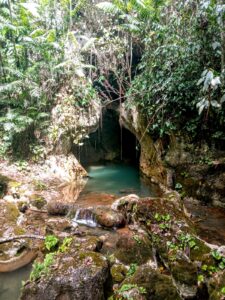
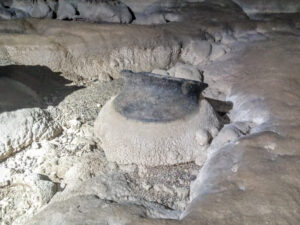
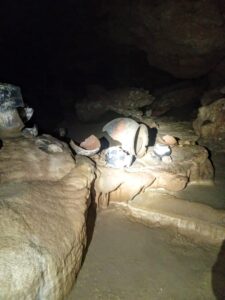
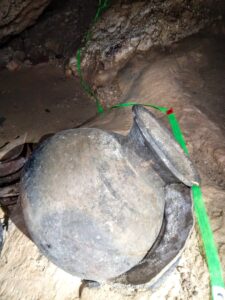
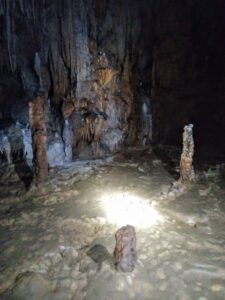
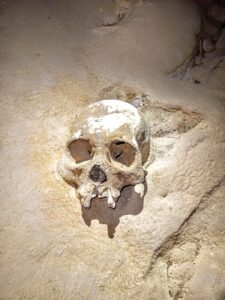
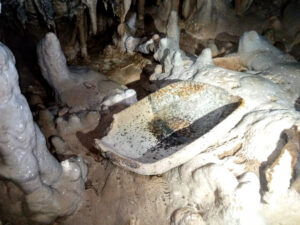
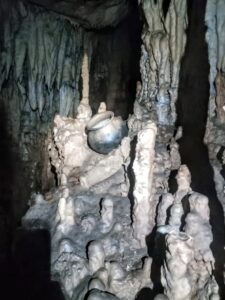
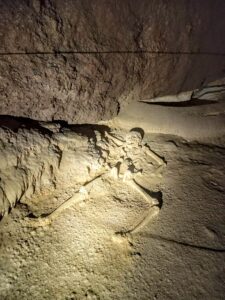
Our guide Emil’s approach is to take groups in early and on our way in we’d been on our own pretty much all the way, however on our way out we came across all of the other groups who were working their way into the cave. We went a slightly different way on the way out, at one point squeezing between two rocks where you had to turn your head to the right angle to allow you to slip through, but soon enough we were swimming our way out of the cave again and walking back to our starting point. Back at the van a delicious and filling lunch was waiting for us and we got chatting with the other people from our group, including a couple who had just started a 10 month trip.
After the cave adventure we came back to town and walked up to AJAW Chocolate. We had learnt about cacao and the origins of chocolate a long time ago in Ecuador, so we’d avoided doing another chocolate tour in Central America so far. However, having enjoyed the coffee tour in El Salvador we decided we’d go for it. I’m glad we did, it was really interesting and a very different approach to the Ecuador tour. In this tour we learnt more about the Mayan use of cacao. We got to try it in various different forms, from raw bean through to a hot chocolate with chilli and all-spice. We also learned about how chocolate came to Europe, and what the Mayan culture thinks about our adulteration of cacao to milk chocolate!
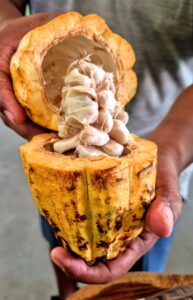
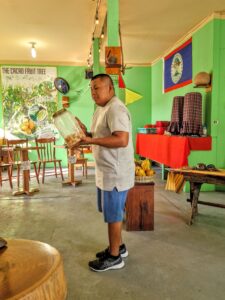
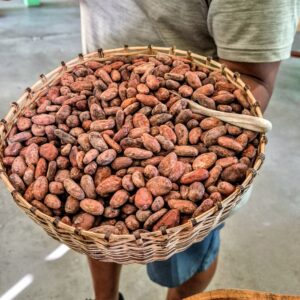
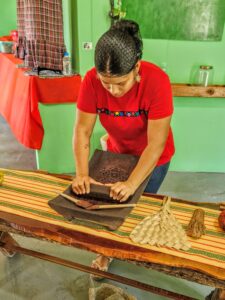
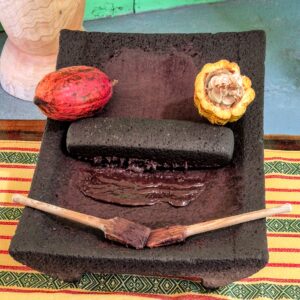
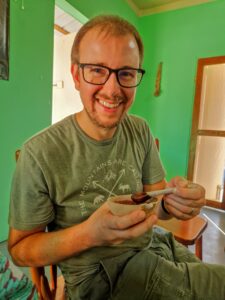
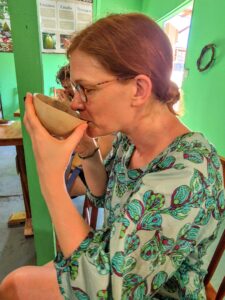
On our final evening we went for a meal out at Ko-Ox Han Nah (which translates to Let’s Go Eat) where they serve more traditional local food. They did some tasty veggie options so we enjoyed a couple of vegetable curries. We walked back to the cabin to enjoy a last beer on the porch and pack our backpacks for the last time.
Then suddenly it was our last morning in Belize and last day of the whole trip! We headed direct to the airport in a shuttle, it ended up being a private shuttle so it was expensive (as with most things in Belize compared to elsewhere on this trip), but it was good to get a reliable ride.
The three month sabbatical has really flown by. We’ve seen six countries in total, visited the Caribbean and Pacific coasts, climbed very high volcanoes, learnt new things and challenged ourselves, all whilst meeting some amazing people. Someone asked us along the way whether we got bored because “all Central American countries are the same”! We can definitely say they are not the same, and we’ve enjoyed the diversity of people and nature throughout. Although I may take a break from rice and beans for a little while.
